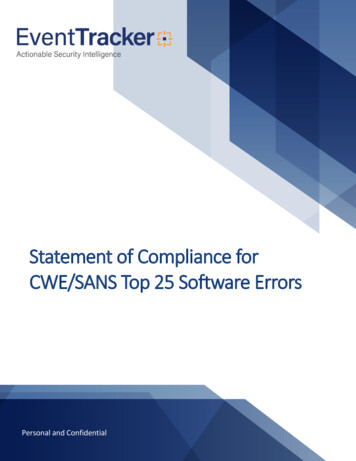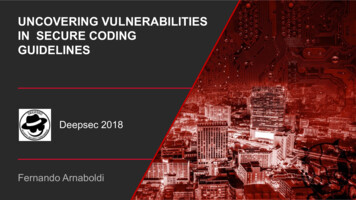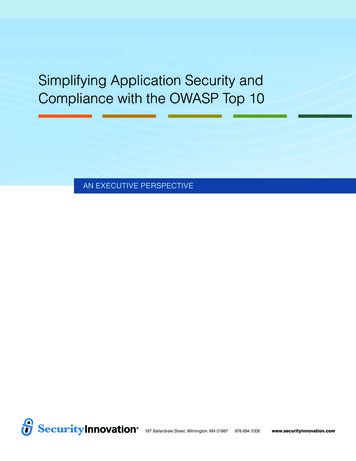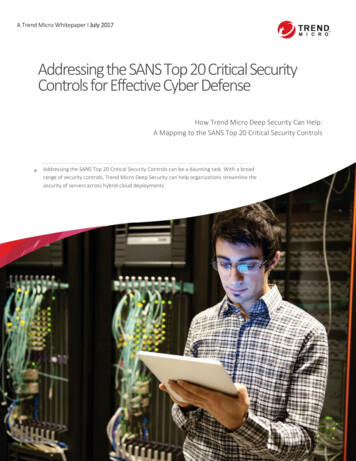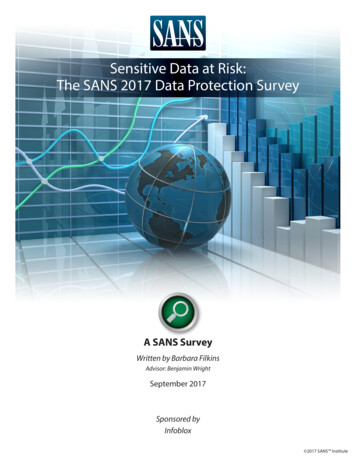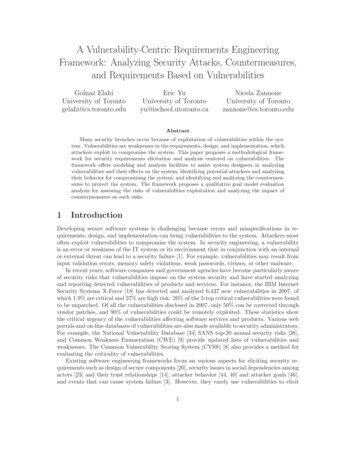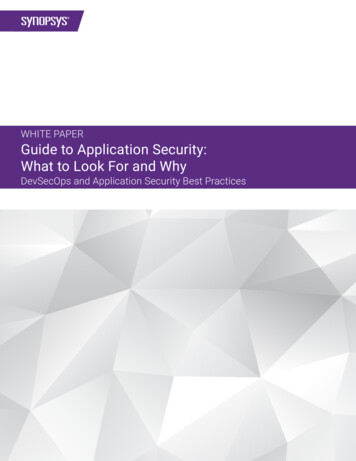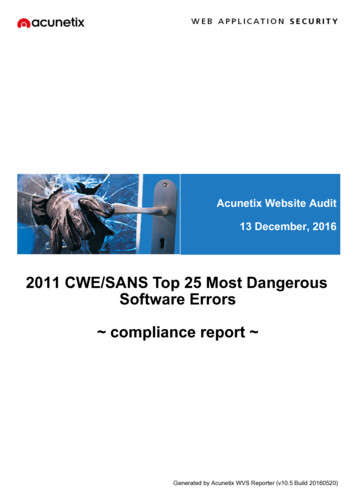
Transcription
Acunetix Website Audit13 December, 20162011 CWE/SANS Top 25 Most DangerousSoftware Errors compliance report Generated by Acunetix WVS Reporter (v10.5 Build 20160520)
2011 CWE/SANS Top 25 Most Dangerous Software Errorscompliance reportDescriptionThe 2011 CWE/SANS Top 25 Most Dangerous Software Errors is a list of the most widespread and critical errors thatcan lead to serious vulnerabilities in software. They are often easy to find, and easy to exploit. They are dangerousbecause they will frequently allow attackers to completely take over the software, steal data, or prevent the software fromworking at all.The Top 25 list is a tool for education and awareness to help programmers to prevent the kinds of vulnerabilities thatplague the software industry, by identifying and avoiding all-too-common mistakes that occur before software is evenshipped. Software customers can use the same list to help them to ask for more secure software. Researchers insoftware security can use the Top 25 to focus on a narrow but important subset of all known security weaknesses.Finally, software managers and CIOs can use the Top 25 list as a measuring stick of progress in their efforts to securetheir software.The list is the result of collaboration between the SANS Institute, MITRE, and many top software security experts in theUS and Europe. It leverages experiences in the development of the SANS Top 20 attack vectors(http://www.sans.org/top20/) and MITRE's Common Weakness Enumeration (CWE) (http://cwe.mitre.org/). MITREmaintains the CWE web site, with the support of the US Department of Homeland Security's National Cyber SecurityDivision, presenting detailed descriptions of the top 25 programming errors along with authoritative guidance formitigating and avoiding them. The CWE site contains data on more than 800 programming errors, design errors, andarchitecture errors that can lead to exploitable vulnerabilities.DisclaimerThis document or any of its content cannot account for, or be included in any form of legal advice. The outcome of avulnerability scan (or security evaluation) should be utilized to ensure that diligent measures are taken to lower the risk ofpotential exploits carried out to compromise data.Legal advice must be supplied according to its legal context. All laws and the environments in which they are applied, areconstantly changed and revised. Therefore no information provided in this document may ever be used as an alternativeto a qualified legal body or representative.This document was generated using information provided in "2010 CWE/SANS Top 25 Most Dangerous SoftwareErrors", that can be found at http://cwe.mitre.org/top25/.ScanURLScan 2/13/2016 6:36:48 PM1 hours, 19 minutesDefaultCompliance at a GlanceThis section of the report is a summary and lists the number of alerts found according to individual compliancecategories.-Improper Neutralization of Special Elements used in an SQL Command ('SQL Injection') (1)Total number of alerts in this category: 149Improper Neutralization of Special Elements used in an OS Command ('OS Command Injection') (2)No alerts in this categoryBuffer Copy without Checking Size of Input ('Classic Buffer Overflow') (3)Total number of alerts in this category: 1Acunetix Website Audit2
-Improper Neutralization of Input During Web Page Generation ('Cross-site Scripting') (4)Total number of alerts in this category: 76Missing Authentication for Critical Function (5)No alerts in this categoryImproper Access Control (Authorization) (6)No alerts in this categoryUse of Hard-coded Credentials (7)No alerts in this categoryMissing Encryption of Sensitive Data (8)Total number of alerts in this category: 1Unrestricted Upload of File with Dangerous Type (9)No alerts in this categoryReliance on Untrusted Inputs in a Security Decision (10)No alerts in this categoryExecution with Unnecessary Privileges (11)No alerts in this categoryCross-Site Request Forgery (CSRF) (12)Total number of alerts in this category: 11Improper Limitation of a Pathname to a Restricted Directory ('Path Traversal') (13)Total number of alerts in this category: 4Download of Code Without Integrity Check (14)No alerts in this categoryIncorrect Authorization (15)No alerts in this categoryInclusion of Functionality from Untrusted Control Sphere (16)Total number of alerts in this category: 38Incorrect Permission Assignment for Critical Resource (17)Total number of alerts in this category: 71Use of Potentially Dangerous Function (18)No alerts in this categoryUse of a Broken or Risky Cryptographic Algorithm (19)No alerts in this categoryIncorrect Calculation of Buffer Size (20)Total number of alerts in this category: 1Improper Restriction of Excessive Authentication Attempts (21)No alerts in this categoryURL Redirection to Untrusted Site ('Open Redirect') (22)Total number of alerts in this category: 1Uncontrolled Format String (23)No alerts in this categoryInteger Overflow or Wraparound (24)No alerts in this categoryUse of a One-Way Hash without a Salt (25)No alerts in this categoryAcunetix Website Audit3
Compliance According to Categories: A Detailed ReportThis section is a detailed report that explains each vulnerability found according to individual compliance categories.(1) Improper Neutralization of Special Elements used in an SQL Command ('SQL Injection')These days, it seems as if software is all about the data: getting it into the database, pulling it from the database,massaging it into information, and sending it elsewhere for fun and profit. If attackers can influence the SQL that you useto communicate with your database, then suddenly all your fun and profit belongs to them. If you use SQL queries insecurity controls such as authentication, attackers could alter the logic of those queries to bypass security. They couldmodify the queries to steal, corrupt, or otherwise change your underlying data. They'll even steal data one byte at a time ifthey have to, and they have the patience and know-how to do so.Total number of alerts in this category: 149Alerts in this categoryBlind SQL InjectionThis script is possibly vulnerable to SQL Injection attacks.SQL injection is a vulnerability that allows an attacker to alter back-end SQL statements by manipulating the user input.An SQL injection occurs when web applications accept user input that is directly placed into a SQL statement and doesn'tproperly filter out dangerous characters.This is one of the most common application layer attacks currently being used on the Internet. Despite the fact that it isrelatively easy to protect against, there is a large number of web applications vulnerable.CVSSBase Score: 6.8CVSS3- Access Vector: Network- Access Complexity: Medium- Authentication: None- Confidentiality Impact: Partial- Integrity Impact: Partial- Availability Impact: PartialBase Score: 10CWE- Attack Vector: Network- Attack Complexity: Low- Privileges Required: None- User Interaction: None- Scope: Changed- Confidentiality Impact: High- Integrity Impact: High- Availability Impact: NoneCWE-89Affected item/Affected parameter loginVariants2Affected item/AJAX/infoartist.phpAffected parameter idVariants2Affected item/AJAX/infocateg.phpAffected parameter idVariants2Affected item/AJAX/infotitle.phpAffected parameter idVariants2Affected item/artists.phpAffected parameter artistAcunetix Website Audit4
VariantsAffected itemAffected parameterVariants2/artists.phplogin2Affected itemAffected parameterVariantsAffected itemAffected ffected item/guestbook.phpAffected parameter loginVariants2Affected itemAffected parameterVariantsAffected itemAffected parameterVariantsAffected itemAffected ucts.phpcat4/listproducts.phplogin2Affected item/Mod Rewrite Shop/buy.phpAffected parameter idVariants2Affected item/Mod Rewrite Shop/details.phpAffected parameter idVariants2Affected item/Mod Rewrite Shop/rate.phpAffected parameter idVariants2Affected itemAffected parameterVariantsAffected itemAffected 2Affected itemAffected parameterVariantsAffected itemAffected parameterVariantsAffected itemAffected hFor4/search.phptest4Affected item/secured/newuser.phpAffected parameter uunameVariants2Affected item/sendcommand.phpAcunetix Website Audit5
Affected parameter cart idVariants2Affected itemAffected parameterVariantsAffected itemAffected parameterVariantsAffected itemAffected parameterVariantsAffected itemAffected parameterVariantsAffected itemAffected parameterVariantsAffected itemAffected nfo.phpuphone2/userinfo.phpurname2Macromedia Dreamweaver remote database scriptsMacromedia Dreamweaver has created a directory ( mmServerScripts or mmDBScripts) that contains scripts for testingdatabase connectivity. One of these scripts (mmhttpdb.php or mmhttpdb.asp) can be accessed without user ID orpassword and contains numerous operations, such as listing Datasource Names or executing arbitrary SQL queries.CVSSBase Score: 5.0CWECVE- Access Vector: Network- Access Complexity: Low- Authentication: None- Confidentiality Impact: Partial- Integrity Impact: None- Availability Impact: NoneCWE-16CVE-2004-1893Affected item/Affected parameterVariants1SQL injectionThis script is possibly vulnerable to SQL Injection attacks.SQL injection is a vulnerability that allows an attacker to alter back-end SQL statements by manipulating the user input.An SQL injection occurs when web applications accept user input that is directly placed into a SQL statement and doesn'tproperly filter out dangerous characters.This is one of the most common application layer attacks currently being used on the Internet. Despite the fact that it isrelatively easy to protect against, there is a large number of web applications vulnerable.CVSSBase Score: 6.8- Access Vector: Network- Access Complexity: Medium- Authentication: None- Confidentiality Impact: Partial- Integrity Impact: Partial- Availability Impact: PartialCVSS3Base Score: 10Acunetix Website Audit6
CWE- Attack Vector: Network- Attack Complexity: Low- Privileges Required: None- User Interaction: None- Scope: Changed- Confidentiality Impact: High- Integrity Impact: High- Availability Impact: NoneCWE-89Affected item/Affected parameter loginVariants2Affected itemAffected parameterVariantsAffected itemAffected QL injection (verified)This script is possibly vulnerable to SQL Injection attacks.SQL injection is a vulnerability that allows an attacker to alter back-end SQL statements by manipulating the user input.An SQL injection occurs when web applications accept user input that is directly placed into a SQL statement and doesn'tproperly filter out dangerous characters.This is one of the most common application layer attacks currently being used on the Internet. Despite the fact that it isrelatively easy to protect against, there is a large number of web applications vulnerable.CVSSBase Score: 6.8CVSS3- Access Vector: Network- Access Complexity: Medium- Authentication: None- Confidentiality Impact: Partial- Integrity Impact: Partial- Availability Impact: PartialBase Score: 10CWE- Attack Vector: Network- Attack Complexity: Low- Privileges Required: None- User Interaction: None- Scope: Changed- Confidentiality Impact: High- Integrity Impact: High- Availability Impact: NoneCWE-89Affected item/AJAX/infoartist.phpAffected parameter idVariants2Affected item/AJAX/infocateg.phpAffected parameter idVariants2Affected item/AJAX/infotitle.phpAffected parameter idVariants2Acunetix Website Audit7
Affected itemAffected parameterVariantsAffected itemAffected gin2Affected item/guestbook.phpAffected parameter loginVariants2Affected itemAffected parameterVariantsAffected itemAffected parameterVariantsAffected itemAffected ucts.phpcat4/listproducts.phplogin2Affected item/Mod Rewrite Shop/buy.phpAffected parameter idVariants2Affected item/Mod Rewrite Shop/details.phpAffected parameter idVariants2Affected item/Mod Rewrite Shop/rate.phpAffected parameter idVariants2Affected itemAffected parameterVariantsAffected itemAffected 2Affected itemAffected parameterVariantsAffected itemAffected parameterVariantsAffected itemAffected hFor4/search.phptest4Affected item/secured/newuser.phpAffected parameter uunameVariants2Affected item/sendcommand.phpAffected parameter cart idVariants4Affected item/userinfo.phpAffected parameter loginAcunetix Website Audit8
VariantsAffected itemAffected parameterVariantsAffected itemAffected parameterVariantsAffected itemAffected parameterVariantsAffected itemAffected parameterVariantsAffected itemAffected parameterVariantsAffected itemAffected parameterVariantsAffected itemAffected ame4(2) Improper Neutralization of Special Elements used in an OS Command ('OS CommandInjection')Your software is often the bridge between an outsider on the network and the internals of your operating system. Whenyou invoke another program on the operating system, but you allow untrusted inputs to be fed into the command stringthat you generate for executing that program, then you are inviting attackers to cross that bridge into a land of riches byexecuting their own commands instead of yours.No alerts in this category.(3) Buffer Copy without Checking Size of Input ('Classic Buffer Overflow')Buffer overflows are Mother Nature's little reminder of that law of physics that says: if you try to put more stuff into acontainer than it can hold, you're going to make a mess. The scourge of C applications for decades, buffer overflows havebeen remarkably resistant to elimination. However, copying an untrusted input without checking the size of that input isthe simplest error to make in a time when there are much more interesting mistakes to avoid. That's why this type ofbuffer overflow is often referred to as "classic." It's decades old, and it's typically one of the first things you learn about inSecure Programming 101.Total number of alerts in this category: 1Alerts in this categorynginx SPDY heap buffer overflowA heap-based buffer overflow in the SPDY implementation in nginx 1.3.15 before 1.4.7 and 1.5.x before 1.5.12 allowsremote attackers to execute arbitrary code via a crafted request. The problem affects nginx compiled with thengx http spdy module module (which is not compiled by default) and without --with-debug configure option, if the "spdy"option of the "listen" directive is used in a configuration file.CVSSBase Score: 5.1CWECVE- Access Vector: Network- Access Complexity: High- Authentication: None- Confidentiality Impact: Partial- Integrity Impact: Partial- Availability Impact: PartialCWE-122CVE-2014-0133Acunetix Website Audit9
Affected itemWeb ServerAffected parameterVariants1(4) Improper Neutralization of Input During Web Page Generation ('Cross-site Scripting')Cross-site scripting (XSS) is one of the most prevalent, obstinate, and dangerous vulnerabilities in web applications. It'spretty much inevitable when you combine the stateless nature of HTTP, the mixture of data and script in HTML, lots ofdata passing between web sites, diverse encoding schemes, and feature-rich web browsers. If you're not careful,attackers can inject Javascript or other browser-executable content into a web page that your application generates. Yourweb page is then accessed by other users, whose browsers execute that malicious script as if it came from you (because,after all, it *did* come from you). Suddenly, your web site is serving code that you didn't write. The attacker can use avariety of techniques to get the input directly into your server, or use an unwitting victim as the middle man in a technicalversion of the "why do you keep hitting yourself?" game.Total number of alerts in this category: 76Alerts in this categoryCross site scriptingThis script is possibly vulnerable to Cross Site Scripting (XSS) attacks.Cross site scripting (also referred to as XSS) is a vulnerability that allows an attacker to send malicious code (usually inthe form of Javascript) to another user. Because a browser cannot know if the script should be trusted or not, it willexecute the script in the user context allowing the attacker to access any cookies or session tokens retained by thebrowser.CVSSBase Score: 6.4CVSS3- Access Vector: Network- Access Complexity: Low- Authentication: None- Confidentiality Impact: Partial- Integrity Impact: Partial- Availability Impact: NoneBase Score: 5.3CWE- Attack Vector: Network- Attack Complexity: Low- Privileges Required: None- User Interaction: None- Scope: Unchanged- Confidentiality Impact: None- Integrity Impact: Low- Availability Impact: NoneCWE-79Affected item/showimage.phpAffected parameter fileVariants4Cross site scripting (verified)This script is possibly vulnerable to Cross Site Scripting (XSS) attacks.Cross site scripting (also referred to as XSS) is a vulnerability that allows an attacker to send malicious code (usually inthe form of Javascript) to another user. Because a browser cannot know if the script should be trusted or not, it willexecute the script in the user context allowing the attacker to access any cookies or session tokens retained by thebrowser.Acunetix Website Audit10
CVSSBase Score: 6.4CVSS3- Access Vector: Network- Access Complexity: Low- Authentication: None- Confidentiality Impact: Partial- Integrity Impact: Partial- Availability Impact: NoneBase Score: 5.3CWE- Attack Vector: Network- Attack Complexity: Low- Privileges Required: None- User Interaction: None- Scope: Unchanged- Confidentiality Impact: None- Integrity Impact: Low- Availability Impact: NoneCWE-79Affected item/404.phpAffected parameterVariants2Affected item/AJAX/showxml.phpAffected parameter mycookieVariants2Affected item/comment.phpAffected parameter nameVariants2Affected itemAffected parameterVariantsAffected itemAffected text4Affected item/hpp/Affected parameter ppVariants2Affected item/hpp/index.phpAffected parameter ppVariants2Affected itemAffected parameterVariantsAffected itemAffected p4Affected itemAffected parameterVariantsAffected itemAffected ucts.phpcat4Affected item/search.phpAcunetix Website Audit11
Affected parameter searchForVariants4Affected itemAffected parameterVariantsAffected itemAffected parameterVariantsAffected itemAffected parameterVariantsAffected itemAffected parameterVariantsAffected itemAffected parameterVariantsAffected itemAffected 2/secured/newuser.phpuuname2Affected itemAffected parameterVariantsAffected itemAffected parameterVariantsAffected itemAffected parameterVariantsAffected itemAffected parameterVariantsAffected itemAffected rinfo.phpurname4Cross site scripting (content-sniffing)This type of XSS can only be triggered on (and affects) content sniffing browsers.This script is possibly vulnerable to Cross Site Scripting (XSS) attacks.Cross site scripting (also referred to as XSS) is a vulnerability that allows an attacker to send malicious code (usually inthe form of Javascript) to another user. Because a browser cannot know if the script should be trusted or not, it willexecute the script in the user context allowing the attacker to access any cookies or session tokens retained by thebrowser.CVSSBase Score: 6.4CVSS3- Access Vector: Network- Access Complexity: Low- Authentication: None- Confidentiality Impact: Partial- Integrity Impact: Partial- Availability Impact: NoneBase Score: 5.3- Attack Vector: Network- Attack Complexity: LowAcunetix Website Audit12
CWE- Privileges Required: None- User Interaction: None- Scope: Unchanged- Confidentiality Impact: None- Integrity Impact: Low- Availability Impact: NoneCWE-79Affected item/showimage.phpAffected parameter fileVariants4(5) Missing Authentication for Critical FunctionIn countless action movies, the villain breaks into a high-security building by crawling through heating ducts or pipes,scaling elevator shafts, or hiding under a moving cart. This works because the pathway into the building doesn't have allthose nosy security guards asking for identification. Software may expose certain critical functionality with the assumptionthat nobody would think of trying to do anything but break in through the front door. But attackers know how to case a jointand figure out alternate ways of getting into a system.No alerts in this category.(6) Improper Access Control (Authorization)Suppose you're hosting a house party for a few close friends and their guests. You invite everyone into your living room,but while you're catching up with one of your friends, one of the guests raids your fridge, peeks into your medicine cabinet,and ponders what you've hidden in the nightstand next to your bed. Software faces similar authorization problems thatcould lead to more dire consequences. If you don't ensure that your software's users are only doing what they're allowedto, then attackers will try to exploit your improper authorization and exercise unauthorized functionality that you onlyintended for restricted users.No alerts in this category.(7) Use of Hard-coded CredentialsHard-coding a secret password or cryptograpic key into your program is bad manners, even though it makes it extremelyconvenient - for skilled reverse engineers. While it might shrink your testing and support budgets, it can reduce thesecurity of your customers to dust. If the password is the same across all your software, then every customer becomesvulnerable if (rather, when) your password becomes known. Because it's hard-coded, it's usually a huge pain forsysadmins to fix. And you know how much they love inconvenience at 2 AM when their network's being hacked - about asmuch as you'll love responding to hordes of angry customers and reams of bad press if your little secret should get out.Most of the CWE Top 25 can be explained away as an honest mistake; for this issue, though, customers won't see it thatway. Another way that hard-coded credentials arise is through unencrypted or obfuscated storage in a configuration file,registry key, or other location that is only intended to be accessible to an administrator. While this is much more politethan burying it in a binary program where it can't be modified, it becomes a Bad Idea to expose this file to outsidersthrough lax permissions or other means.No alerts in this category.(8) Missing Encryption of Sensitive DataWhenever sensitive data is being stored or transmitted anywhere outside of your control, attackers may be looking forways to get to it. Thieves could be anywhere - sniffing your packets, reading your databases, and sifting through your filesystems. If your software sends sensitive information across a network, such as private data or authentication credentials,that information crosses many different nodes in transit to its final destination. Attackers can sniff this data right off thewire, and it doesn't require a lot of effort. All they need to do is control one node along the path to the final destination,control any node within the same networks of those transit nodes, or plug into an available interface. If your softwarestores sensitive information on a local file or database, there may be other ways for attackers to get at the file. They maybenefit from lax permissions, exploitation of another vulnerability, or physical theft of the disk. You know those massivecredit card thefts you keep hearing about? Many of them are due to unencrypted storage.Total number of alerts in this category: 1Alerts in this categoryUser credentials are sent in clear textUser credentials are transmitted over an unencrypted channel. This information should always be transferred via anencrypted channel (HTTPS) to avoid being intercepted by malicious users.Acunetix Website Audit13
CVSSBase Score: 5.0CVSS3- Access Vector: Network- Access Complexity: Low- Authentication: None- Confidentiality Impact: Partial- Integrity Impact: None- Availability Impact: NoneBase Score: 9.1CWE- Attack Vector: Network- Attack Complexity: Low- Privileges Required: None- User Interaction: None- Scope: Unchanged- Confidentiality Impact: High- Integrity Impact: High- Availability Impact: NoneCWE-310Affected item/signup.phpAffected parameterVariants1(9) Unrestricted Upload of File with Dangerous TypeYou may think you're allowing uploads of innocent images (rather, images that won't damage your system - the Interweb'snot so innocent in some places). But the name of the uploaded file could contain a dangerous extension such as .phpinstead of .gif, or other information (such as content type) may cause your server to treat the image like a big honkin'program. So, instead of seeing the latest paparazzi shot of your favorite Hollywood celebrity in a compromising position,you'll be the one whose server gets compromised.No alerts in this category.(10) Reliance on Untrusted Inputs in a Security DecisionIn countries where there is a minimum age for purchasing alcohol, the bartender is typically expected to verify thepurchaser's age by checking a driver's license or other legally acceptable proof of age. But if somebody looks old enoughto drink, then the bartender may skip checking the license altogether. This is a good thing for underage customers whohappen to look older. Driver's licenses may require close scrutiny to identify fake licenses, or to determine if a person isusing someone else's license. Software developers often rely on untrusted inputs in the same way, and when these inputsare used to decide whether to grant access to restricted resources, trouble is just around the corner.No alerts in this category.(11) Execution with Unnecessary PrivilegesYour software may need special privileges to perform certain operations, but wielding those privileges longer thannecessary can be extremely risky. When running with extra privileges, your application has access to resources that theapplication's user can't directly reach. For example, you might intentionally launch a separate program, and that programallows its user to specify a file to open; this feature is frequently present in help utilities or editors. The user can accessunauthorized files through the launched program, thanks to those extra privileges. Command execution can happen in asimilar fashion. Even if you don't launch other programs, additional vulnerabilities in your software could have moreserious consequences than if it were running at a lower privilege level.No alerts in this category.Acunetix Website Audit14
(12) Cross-Site Request Forgery (CSRF)You know better than to accept a package from a stranger at the airport. It could contain dangerous contents. Plus, ifanything goes wrong, then it's going to look as if you did it, because you're the one with the package when you board theplane. Cross-site request forgery is like that strange package, except the attacker tricks a user into activating a requestthat goes to your site. Thanks to scripting and the way the web works in general, the user might not even be aware thatthe request is being sent. But once the request gets to your server, it looks as if it came from the user, not the attacker.This might not seem like a big deal, but the attacker has essentially masqueraded as a legitimate user and gained all thepotential access that the user has. This is especially handy when the user has administrator privileges, resulting in acomplete compromise of your application's functionality. When combined with XSS, the result can be extensive anddevastating. If you've heard about XSS worms that stampede through very large web sites in a matter of minutes, there'susually CSRF feeding them.Total number of alerts in this category: 11Alerts in this categoryHTML form without CSRF protectionThis alert may be a false positive, manual confirmation is required.Cross-site request forgery, also known as a one-click attack or session riding and abbreviated as CSRF or XSRF, is atype of malicious exploit of a website whereby unauthorized commands are transmitted from a user that the websitetrusts.Acunetix WVS found a HTML form with no apparent CSRF protection implemented. Consult details for more informationabout the affected HTML form.CVSSBase Score: 2.6CVSS3- Access Vector: Network- Access Complexity: High- Authentication: None- Confidentiality Impact: None- Integrity Impact: Partial- Availability Impact: NoneBase Score: 4.3CWE- Attack Vector: Network- Attack Complexity: Low- Privileges Required: None- User Interaction: Required- Scope: Unchanged- Confidentiality Impact: None- Integrity Impact: Low- Availability Impact: NoneCWE-352Affected item/Affected parameter Unnamed FormVariants2Affected item/comment.php (7aae61e4ef757b75f29861b71d32976e)Affected parameter fCommentVariants2Affected item/hpp (fbc1d56ba0737d3fa577aa5a19c9fd49)Affected parameter Unnamed FormVariants2Affected item/signup.phpAffected parameter form1Variants2Affected item/userinfo.php (9d1db3f4d16732c9716e14a3e959fa2d)Affected parameter form1Variants2Acunetix Website Audit15
Possible CSRF (Cross-site request forgery)Manual confirmation is required for this alert.This
Finally, software managers and CIOs can use the Top 25 list as a measuring stick of progress in their efforts to secure their software. The list is the result of collaboration between the SANS Institute, MITRE, and many top software security experts in the US and Europe. It leverages experiences in the development of the SANS Top 20 attack vectors
